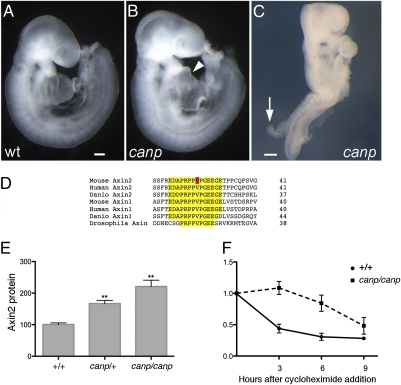Fig. 1.
A mutation in Axin2 disrupts embryonic morphogenesis and slows protein turnover. (A–C) The e9.5 Axin2canp mutant phenotype. Unlike the wild-type embryo (A), Axin2canp mutants have abnormal hearts (arrowhead), slightly shorter tails, and about 30% are exencephalic, like the one shown here (B). (C) A homozygous Axin2canp embryo of the double tail class, with a short tail-like protrusion on the dorsal side of the embryo (arrow). (D) The V26D missense mutation (red) in Axin2canp lies in a highly conserved motif in Axin2 (yellow). (E) Western blot data (Fig. S1) from three e9.0 litters showed that the level of Axin2 was increased 1.6-fold in heterozygous and 2.2-fold in homozygous Axin2canp embryos relative to wild type. The amount of Axin2 protein in both homozygous and heterozygous embryos was significantly higher than in wild type (P < 0.001). (F) Turnover of Axin2 protein in MEFs. Wild-type and Axin2canp homozygous MEFs were cultured with 20 μg/mL cycloheximide (CHX) for the indicated number of hours and analyzed by Western blot (Fig. S1). The Axin2canp mutation increased the half-life of Axin2 from 1.4 h to 4.6 h.

